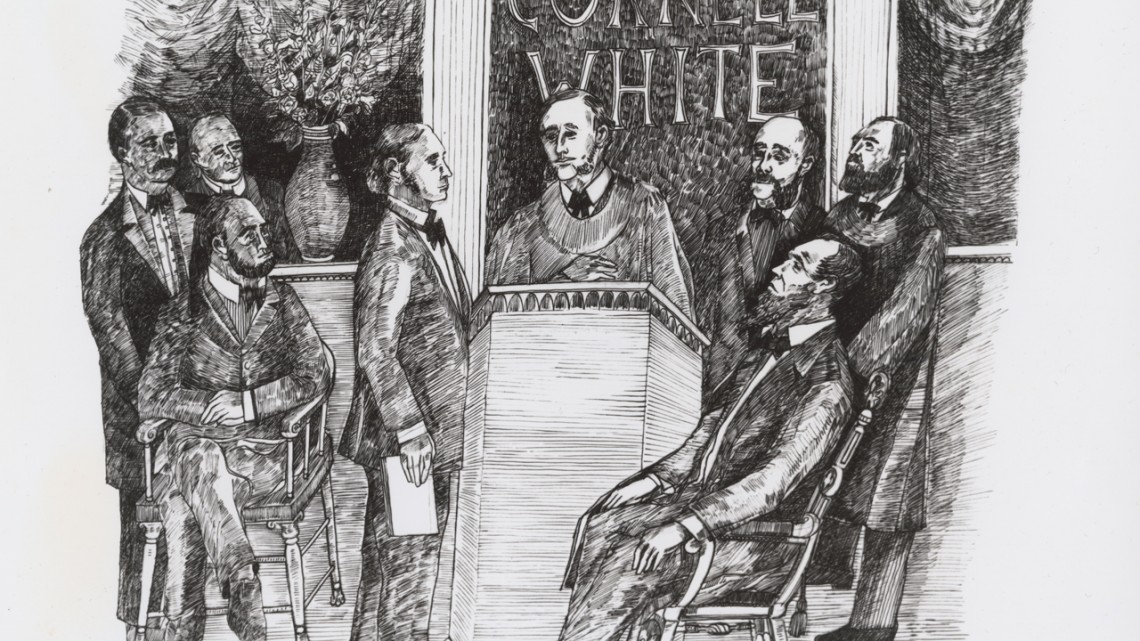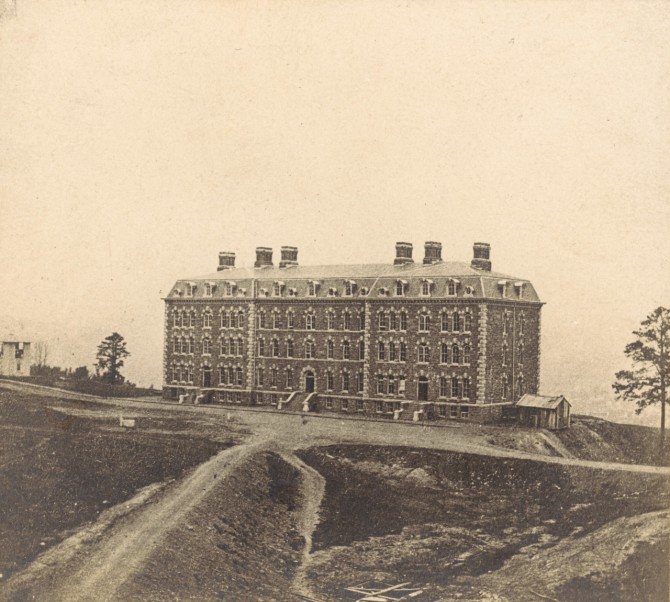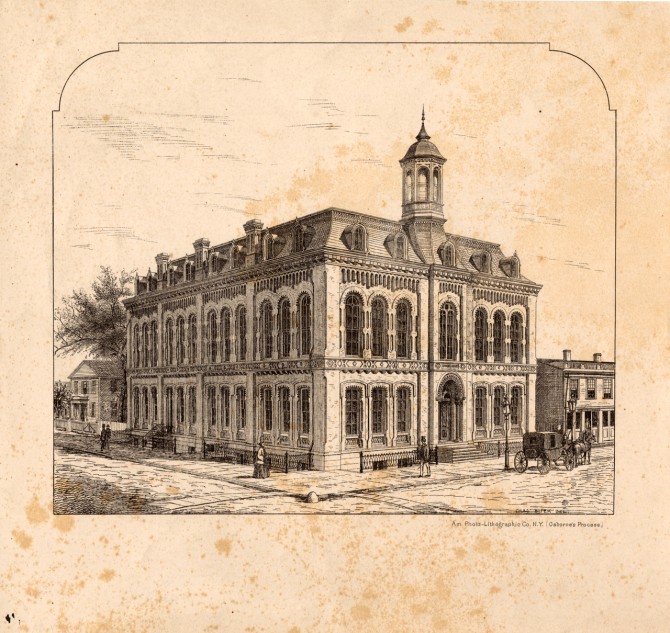
This artists’ conception of the inauguration of Andrew Dickson White as Cornell's first president in October 1868 was created by Cornell MFA alumni Victoria Romanoff (’64) and Murray Zimiles (’65) in 1995. White is pictured at the lectern giving his inaugural address; joining him, from left, are Charles Hartt, professor of geology; Louis Agassiz, nonresident professor of natural history; George Caldwell (seated), professor of agricultural chemistry; George William Curtis, nonresident professor of literature; New York Lt. Gov. Stewart Woodford; Ezra Cornell (seated), the university's founder; and William Cleveland, professor of civil engineering.
150 years ago this fall, Cornell opened its doors
By
In 2015, Cornell University celebrated the sesquicentennial of its Charter Day, the anniversary of a signature on a piece of paper that officially created the university.
Gov. Reuben Fenton signed Cornell’s charter into law on April 27, 1865, beginning what would be a three-year process to build an innovative new university. But the 150th birthday of Cornell University as an institution – up and running with classrooms, students and faculty – is Oct. 7, 2018, the sesquicentennial of Cornell’s Inauguration Day.
By 1868, co-founders Ezra Cornell and Andrew Dickson White had exhausted themselves building a university from that signed piece of paper that had given it life. Cornell purchased equipment and oversaw construction of Morrill and White halls (then called South University and North University) on a portion of his former farmland on Ithaca’s East Hill, while White sought out books, laboratory apparatus and faculty members. With classrooms and faculty in place on the nascent campus, the missing ingredient – students – arrived on Oct. 6, 1868, to take entrance examinations in subjects like spelling, grammar, mathematics, geography, Latin and Greek.
The following morning, Oct. 7, Cornell’s official inaugural ceremony was held as Ithacans and the new Cornell community gathered downtown at Library Hall, the public library building at the southeast corner of Seneca and Tioga streets given to Ithaca by Ezra Cornell. The building was demolished in 1960.
Cornell and White, both sick from stress and overwork, gave remarks emphasizing the revolutionary founding ideals of the new university: coeducation, nonsectarianism, practical and classical education combined. Large red flannel banners hung behind the speakers at Library Hall, with white lettering identifying founders “Cornell” and “White.” Students soon pointed out that the founders’ names matched the banner colors, with Cornell being similar to carnelian, a shade of red. And thus, Cornell’s official colors of carnelian and white were born.
While New York Gov. Fenton was expected to speak, he had fled town the previous evening, fearing that his association with the radical new institution might be politically unsavvy. The lieutenant governor, Stewart Woodford, attended instead and, White said, “discharged the duties admirably.”
Following morning speeches and a lunch, attendees marched up the hill to campus, where more remarks were given near the site of the present-day clocktower. A wooden stand with nine bells given by Jennie McGraw sat on the location of today’s Uris Library, ringing in the event and beginning Cornell’s oldest musical tradition: the chimes. Fortunately, the weather cooperated and provided a warm and sunny respite from a fall season marked by frequent rains. (As historian Morris Bishop noted, “Faculty and students that year gained an impression of Ithaca weather which still persists.”) George William Curtis, a nonresident professor, gave a powerful speech comparing the university to a newly launched ship with its captain, crew and passengers finally ready to sail. The next day, Oct. 8, 412 students assembled and reported to Cascadilla Hall, marking the largest entering class of any American university up to that point.
While the inauguration ceremonies gave the impression of an institution with a solid foundation and bright future, a nervous White looked around at what he described as a “ragged corn-field” and later wrote, “Probably no ship was ever launched in a condition so unfit to brave the storms.” The founders were both ill, prominent political and religious enemies continued to attack the “godless institution,” financial resources were strained, and the campus and buildings were barely ready (Morrill Hall’s doors had no hinges and White Hall was still under construction).
One hundred and fifty years later, White’s fears have been allayed as his vision for a “truly great university” lives on. Carnelian and white colors abound, the chimes still ring (albeit from a higher elevation) and Cornell still aspires to uphold the founding declaration’s ideals of “... any person … any study.”
Happy anniversary, Cornell University, and best wishes for the next 150 years.
Corey Ryan Earle ’07 is a staff member in Alumni Affairs and Development and teaches AMST 2001: The First American University, a course about Cornell history.
Media Contact
Get Cornell news delivered right to your inbox.
Subscribe

